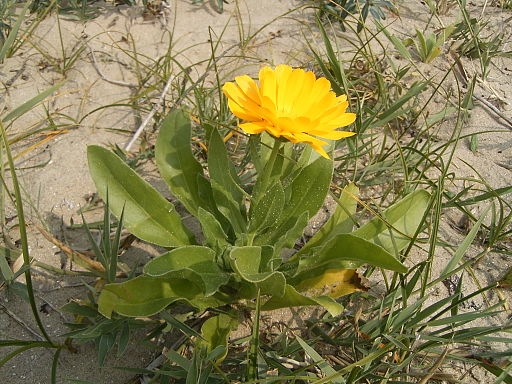Calendula (Calendula officinalis) is an amazing herb. It is probably under-utilized and under-appreciated, so I’m going to give it its due thanks! Calendula is a very old herb, employed since the 12th century in Europe and even earlier in Egypt, where it originated. It is often used as a dye; in fact, cheese was originally dyed yellow by its flower. The larger flowers are more medicinal and make beautiful garden plants. Calendula is sometimes called ‘pot marigold,’ but the common garden marigold is a distinctly different plant. The volatile oils of calendula stimulate blood circulation and cause sweating, thus lowering fevers and assisting skin eruptions to come out faster. For this reason it is specific for the beginning stages of measles, rashes and other eruptive diseases. When my son had the chicken pox, I only had to apply calendula tincture once to each pox for the itching and eruption to stop. Within the day he was feeling much better and the chicken pox rapidly cleared. Calendula oil or wash works well for this, too. In general, calendula is a wonderful herb for cleansing the liver, and as it is neutral to warm in energy, it may safely be used for any type of liver condition without overheating it. As well, it is a great lymphatic cleanser, moving lymphatic congestion in the chest, under the armpit and in the groin area. It is hands down one of the best herbs for any skin problems, and I have seen it useful for fungal conditions (take internally and apply topically). Many mothers find it wonderful for diaper rash. Used as a salve, oil or poultice it promotes the rapid healing of slow-healing wounds and eases persistent ulcers, burns, bruises, boils, rashes, injuries, varicose veins and bleeding, including bleeding hemorrhoids. Like mullein, calendula flowers can be made into oil and used for earaches and other infections. As a natural antiseptic it prevents the growth of harmful bacteria. Cooled calendula tea can be used as eyewash for sore, red and irritated eyes.
Calendula officinalis
Parts used: flowers Energy, taste and Organs affected: neutral to warm; spicy, bitter; Liver, Heart, Lungs Actions: invigorates Blood Properties: vulnerary, emmenagogue, astringent, diaphoretic, antispasmodic, stimulant, antifungal, antiviral, antiseptic, demulcent, anti-inflammatory, cholagogue Biochemical constituents: essential oil containing carotenoids (carotene, calenduline and lycopine), flavonol glycosides, saponins, triterpene alcohols, sterols, carotenes, xanthophylls, polysaccharides, tannins, resin and bitter principle Dose: 3-6 g; infuse 2-3 tablespoons per cup water, drink 3 cups a day; for acute conditions, drink 1 cup tea every hour until symptoms lessen, then drink 1 cup 2-4 times/day until problem is gone Precautions: pregnancy Other: This herb is similar in action, but weaker than, safflower. Indications: fevers, skin eruptions, measles, rashes, chicken pox, skin fungus, diaper rash, wounds that will not heal, ulcers, burns, bruises, boils, injuries, varicose veins, sore, red and irritated eyes

